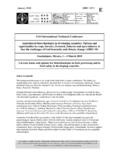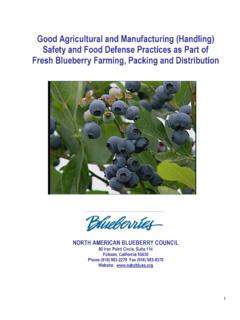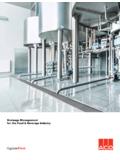Transcription of Best Practices For Foodservice Operations
1 best Practices For Foodservice Operations (Revised 4/19/2005). best Practices FOR Foodservice OPERATONS. BACKGROUND. The United States has 900,000 restaurants with million employees and industry sales of over $476 billion projected for 2006. The restaurant share of the food dollar is estimated at %. Commercial restaurant services include subcategories of eating places such as full and quick service restaurants; Noncommercial restaurant services are located in public and private schools, hospitals, nursing homes, managed or contracted services such as may be in hospitals, universities, airlines; and foodservices associated with lodging facilities.
2 And community centers. Military restaurants are found in mess halls, officer and NCO clubs and associated with military exchanges. Unless these various facilities offer only snacks or unless they are vegetarian-only or seafood-only Operations , most of these facilities handle meat products, including beef. OBJECTIVE. These best Practices for Foodservice Operations feature the minimum recommendations as outlined by current regulations needed to maintain and enhance safety of beef products served to customers of all ages who consume food away from home. best Practices . Broad-based best Practices for Foodservice Operations should be based on regulatory requirements of the food Code and other authorities.
3 best Practices for individual eating establishments also should take into account regulations and requirements specific to certain chain Operations , jurisdictions or locales that may be more stringent than those in the food Code. References to the food Code pertain to the food Code 2001 or Supplement, US Public Health Service FDA, USDHHS. Another reference would be the current Good Manufacturing Practices 21 CFR, Part 110. All food safety components in an establishment must be integrated into the operation's philosophy and culture, whether the operation is a one-site independent Foodservice facility or a large corporate entity with multiple Foodservice venues.
4 food safety must be part of the foundation -- not just part of the building. Personnel All members of the Foodservice organization should have knowledge of food safety principles. food safety training should be conducted at all levels. The training should include: specific employee tasks, sanitation, health and hygiene, monitoring procedures mentioned here, all part of an ongoing program. food safety training must be Hazard Analysis Critical Control Point (HACCP)-based. A program of staff development must be established. In addition to regular staff development, clear accountability for food safety must be established.
5 1. Manager/Person in Charge of the Operation Demonstration of Knowledge - food Code .the person in charge shall demonstrate to the regulatory authority knowledge of foodborne disease prevention, application of the HACCP principles, and the requirements of the Code. Demonstration of knowledge occurs in one of all three ways by: (1) complying with the Code by having no violations during the current inspection, (2)being a certified food protection manager through passing a test that is part of an accredited program, (ServSafe , NEHA National Environmental Health Assn., etc.) or (3) correctly answering questions from the inspector related to the food operation as noted in the Code.
6 2. Employee training and supervision Employees should know what is expected of them in the position they hold and how that relates to maintaining safety of the food . They need documented training at regular intervals and consistent supervision to provide food that is safe every time it is prepared and served. Employee performance should be monitored to verify compliance and measure success. In Facility: Standard Operating Procedures 1) Facility Sanitation Standard Operating Procedures should be developed, written, and followed for operational and post-operational sanitation of the Foodservice facility, including food handling and storage equipment, eating utensils, floors, walls, etc.
7 Sanitation standards should be monitored for compliance and should include documented corrective actions and preventive measures. 2) Sanitation Equipment: Dishwashing machines and 3-compartment sinks must be maintained and operated to function as intended. Hot water temperatures and/or sanitizer concentrations should meet food Code regulation and be monitored and documented. 3) Employee Cleanliness/hygiene - Standard Operating Procedures should be developed, written, and followed for employee cleanliness and hygiene. These include frequent and thorough hand washing, applicable use of gloves/utensils (based upon health department regulations company policy, and food safety assessments) to minimize potential for Hygiene standards should be monitored for compliance and should include documented corrective actions and preventive measures.
8 4) Employee Health: Employees should understand the necessity of avoiding the workplace when showing symptoms of illnesses such as nausea, vomiting, diarrhea, that may lead to food contamination and disease transmission. Refer to food Code Section 5) HACCP. 6) The Foodservice operation should have a documented operational HACCP. program that includes identification of hazards, critical control points, critical limits appropriate to the product and process, specific monitoring, corrective action, verification and record keeping procedures. food . Restaurant and Distribution Center Receiving SOPs should be developed, written and followed for receiving.
9 These include the following: 1) Products must come from a pre-approved supplier. (See supplier section later in this document.). 2) food temperatures at receiving should be monitored to ensure cold-chain integrity so that refrigerated foods are received at 5 C (41 F) or below; frozen foods should be solidly frozen with no signs of temperature abuse. food Code 3) food packages should be in good condition and protect the integrity of contents. food Code Storing 1) Standard operating procedures for cold control should be developed, written, and followed, using first-in/first-out, to assure meat products are kept safe during storage and preparation prior to cooking.
10 2) Refrigerated meat should be stored at 5 C (41 F). food Code 3) Thawing of meat should be accomplished under refrigeration, while submerged under running water, or as part of the cooking process. food Code 4) Frozen meat should be maintained frozen. Cooking: Equipment Cooking equipment must be maintained and calibrated to function as intended. Company-specified cooking equipment parameters such as temperatures and times must be verified, at least daily, to assure proper operation. Standard operating procedures for equipment maintenance and function must be developed, written and followed.





